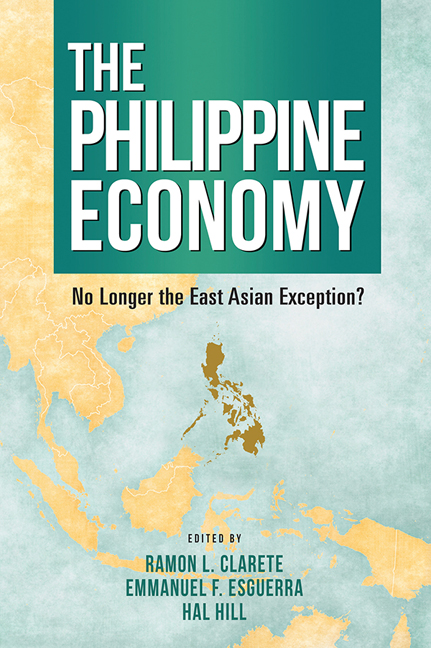Book contents
- Frontmatter
- Contents
- List of Figures
- List of Tables
- Foreword by Arsenio M. Balisacan
- Preface
- About the Contributors
- 1 The Philippine Economy: An Overview
- 2 Economic Growth and Poverty Reduction
- 3 Infrastructure and Urbanization
- 4 Education and Training
- 5 Universal Health Coverage, Health Security and Resilient Health Systems
- 6 Environmental Resources, Shocks and National Well-Being
- 7 Energy: Power Security and Competitiveness
- 8 Development Finance
- 9 Governance and Institutions
- Index
8 - Development Finance
Published online by Cambridge University Press: 12 February 2019
- Frontmatter
- Contents
- List of Figures
- List of Tables
- Foreword by Arsenio M. Balisacan
- Preface
- About the Contributors
- 1 The Philippine Economy: An Overview
- 2 Economic Growth and Poverty Reduction
- 3 Infrastructure and Urbanization
- 4 Education and Training
- 5 Universal Health Coverage, Health Security and Resilient Health Systems
- 6 Environmental Resources, Shocks and National Well-Being
- 7 Energy: Power Security and Competitiveness
- 8 Development Finance
- 9 Governance and Institutions
- Index
Summary
Substantial resources for financing critical development expenditures will be needed to sustain the current economic momentum and meet future socio-economic aspirations. Where should the country get its financial resources to implement priority measures? This chapter looks at three main sources of funds — households and firms, donors, and foreign investors — and examines long-term implications with reference to taxation, the overall financial system, public–private partnerships (PPP), official development assistance (ODA), and remittances. It is imperative for the government to substantially raise tax revenues and rely more on domestic borrowing. ODA and PPP should be used to strategically finance infrastructure needs and emerging regional public goods, respectively. Financial reforms should be geared towards providing access to poor households and micro, small and medium enterprises, as well as financial education for overseas Filipinos and their families, to widen their investment horizons. Related financial inclusion policies and interventions are an important component for achieving the country's long-term vision.
Figure 8.1 provides a convenient framework highlighting the task of raising and channelling funds from the three main sources identified above to be used in policy-determined development expenditures. The new development finance institutions such as the Asian Infrastructure Investment Bank (AIIB) are specifically included in the figure to indicate their potential as another major source of infrastructure finance for the Philippines. In the case of the AIIB, the People's Republic of China (PRC) is positioning itself as the largest international source of loans for infrastructure. The bilateral Philippine–PRC relationship will have a major bearing on how the country can access this source of long-term loans.
Households and firms pay taxes to the government, while the process of financial intermediation transforms the savings of households and firms into an adequate supply of finance for the use of the private and public sectors. Donors provide the government with loans, grants and technical assistance (TA), while foreign and domestic investors participate in PPP by taking an equity position, providing debt finance and engaging in the operation and maintenance (OM) of infrastructure facilities such as rail, ports, toll roads and airports.
Private domestic and foreign investors also tap the financial and capital markets for resources to invest in PPPs for infrastructure. Public sector loans, grants, PPP schemes, and TA provided by donors to the government are utilized to finance critical development expenditures.
- Type
- Chapter
- Information
- The Philippine EconomyNo Longer The East Asian Exception?, pp. 324 - 374Publisher: ISEAS–Yusof Ishak InstitutePrint publication year: 2018

